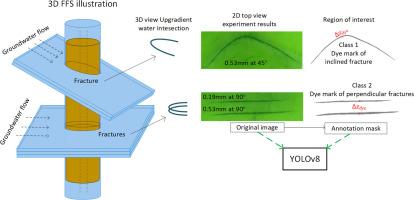Data driven deep learning method for quantifying groundwater flux in deep fractured aquifers with the fractured rock passive flux meter
IF 4.2
2区 环境科学与生态学
Q1 WATER RESOURCES
引用次数: 0
Abstract
Movement of groundwater in fractured aquifers is highly variable and depends on many factors besides fracture apertures. Hence, downhole techniques that directly map fracture locations, orientations, apertures, and measure groundwater fluxes are valuable tools. Here, we explored the possibility of using the Fractured Rock Passive Flux Meter (FRPFM) with visible dye component to measure groundwater fluxes and identify geometric fracture parameters through laboratory experiments. For this purpose, we used the deep learning model YOLOv8 to accurately identify the dye marks and to measure their areas and widths from images of the dyed fabric. Results showed that groundwater fluxes were measured with relative errors of ±23 % and ±16 % based on and , respectively, with an overall relative error of ±20 %. The YOLOv8 model showed very good accuracy by achieving high precision = 0.99 and recall = 0.75 for both object detection and mask predictions. The --curve showed that accuracy can be improved by using more images to train the model.

基于数据驱动深度学习的裂隙岩被动通量仪定量地下水通量方法
裂缝性含水层中地下水的运动是高度可变的,除裂缝孔径外,还取决于许多因素。因此,直接绘制裂缝位置、方向、孔径和测量地下水通量的井下技术是很有价值的工具。在此,我们探索了利用裂隙岩被动通量计(FRPFM)可见染料组分测量地下水通量并通过实验室实验确定几何裂缝参数的可能性。为此,我们使用深度学习模型YOLOv8从染色织物图像中准确识别染料标记,并测量其面积Adye和宽度Δzdye。结果表明,基于Δzdye和Adye的地下水通量测量相对误差分别为±23%和±16%,总体相对误差为±20%。YOLOv8模型在目标检测和掩码预测方面均达到了很高的精度P = 0.99,召回率R = 0.75,显示出非常好的准确性。p - r曲线表明,使用更多的图像来训练模型可以提高模型的精度。
本文章由计算机程序翻译,如有差异,请以英文原文为准。
求助全文
约1分钟内获得全文
求助全文
来源期刊

Advances in Water Resources
环境科学-水资源
CiteScore
9.40
自引率
6.40%
发文量
171
审稿时长
36 days
期刊介绍:
Advances in Water Resources provides a forum for the presentation of fundamental scientific advances in the understanding of water resources systems. The scope of Advances in Water Resources includes any combination of theoretical, computational, and experimental approaches used to advance fundamental understanding of surface or subsurface water resources systems or the interaction of these systems with the atmosphere, geosphere, biosphere, and human societies. Manuscripts involving case studies that do not attempt to reach broader conclusions, research on engineering design, applied hydraulics, or water quality and treatment, as well as applications of existing knowledge that do not advance fundamental understanding of hydrological processes, are not appropriate for Advances in Water Resources.
Examples of appropriate topical areas that will be considered include the following:
• Surface and subsurface hydrology
• Hydrometeorology
• Environmental fluid dynamics
• Ecohydrology and ecohydrodynamics
• Multiphase transport phenomena in porous media
• Fluid flow and species transport and reaction processes
 求助内容:
求助内容: 应助结果提醒方式:
应助结果提醒方式:


